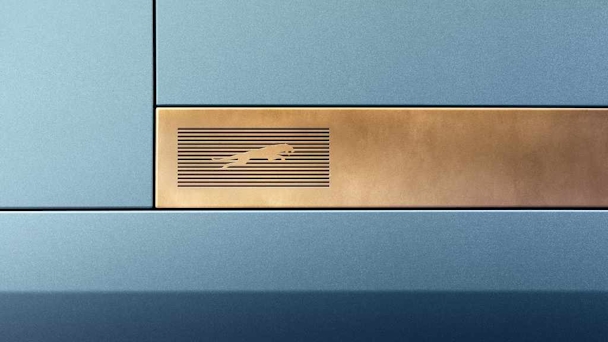Enough scoffing, Jaguar’s rebrand is a roaring success in innovation strategy
The Jaguar rebrand is about lots more than an ad and a new logo, says Sonia Abdipour of Bulletproof. It’s about setting up the brand for the years ahead.

It’s more than just a redesign, explains Abdipour / Jaguar
When it comes to the Jaguar rebrand, you may think it’s all been said. LinkedIn is so flooded with commentary that there are even posts advising followers on how to hide the topic. But here’s the rub: All that noise out there? It’s focused on the wrong thing.
Jaguar’s move isn’t a redesign; it’s not even a rebrand. It’s a fundamental innovation of Jaguar’s business model. If those judging the aesthetic just looked under the hood, they’d see their critiques are evidence of the brave and robust innovation strategy at the heart of the car manufacturer’s shift.
Want to go deeper? Ask The Drum
Heritage abandoned?
Business textbooks are littered with cautionary tales of brands failing to keep up with the pace of cultural change. Like Blockbuster, Blackberry, and Nikon before them, Jaguar was driving full-speed into multiple headwinds – from an aging consumer base to tightened regulations, quality issues, and increased competition.
For years, Jaguar was losing money on every car sold. While owned by Ford, it repositioned as a competitor to Mercedes, BMW, and Audi. Unable to compete on performance against German brands with a strong heritage in it: “The transition into the premium volume segment wasn’t successful,” according to Jaguar’s MD.
Why? Because heritage isn’t a strategy or a benefit. Heritage is the story of a brand’s roots, which can be leveraged to define the business you’re really in. And Jaguar rightly realized it’s not just in the business of cars, it’s in the business of deleting ordinary. This frame of reference for reimagining Jaguar is deeply rooted in words from its founder: “A Jaguar should be a copy of nothing. Don’t be held back by the past, be brave, be fearless”.
Honoring your heritage doesn’t have to feel historic. Reimagining a brand’s unique qualities for the future can not only modernize its heritage but also drive resonance among new audiences. Jaguar has shown how to build an innovation strategy that’s simultaneously steeped in history yet unbound by convention.
Advertisement
Customers alienated?
A growing number of briefs are about driving relevancy with younger demographics. Native gen Z brands, such as skincare company Starface, are so single-minded in their insight that even millennials don’t quite get it. On the other end of the spectrum, iconic brands are spending millions to recruit new consumers, but they often don’t lean far enough into novel insights for fear of alienating their core consumer.
After Ford sold Jaguar to Tata for half of what it paid, Jaguar realized that its core consumer simply wasn’t a viable path to growth. And it’s right. An AI-powered Reddit analysis found that luxury car enthusiasts haven't been talking about the rebrand at all. What does this mean? That Jaguar’s core consumers aren’t actually that engaged with the brand, and Jaguar executives know their growth target has different expectations.
Jaguar’s future customer core is expected to be younger, wealthier, and more urban – a demographic Audi is also doubling down on with the launch of a sub-brand just for the luxury Chinese market. This next-gen ‘cash-rich, time-poor’ creatively minded target audience values innovation over tradition, technology over specs, and storytelling over badges.
Jaguar is boldly leaning into the desires of its future consumer regardless of the consequences with its current core, aspiring towards a P&L with sustainable top and bottom-line growth.
Advertisement
Equity missing?
There’s an intrinsic difference between luxury and premium: while brands like Hermes don’t stretch down, premium brands like Gucci flex price points and equities across collections and outlets. But this good/better/best innovation strategy is becoming less resonant as cost-of-living divides purchasing power, and those desiring luxury seek out curated brand communities built from new expressive codes of luxury.
Jaguar’s ‘Reimagine’ strategy, announced back in 2021, was billed as an: “Exceptional journey of transformation” – a pipeline of innovation shifting their entire portfolio to electric cars starting at £100,000, doubling the current ticket price.
What is the fastest way to drive believability? Showing up differently. Consumers, especially younger demographics, are more skeptical than ever. Anything short of a ‘firebreak’ to create mental distance between past and present would have caused doubt that anything had really changed. But this isn’t just a ‘woke’ redesign; it’s an intentional choice to drive change in every part of the business, with the end game years in the making. For the first time since 1948, no new Jaguars are in production, while the new Type 00 was unveiled in a unique setting at Miami Art Week.
Jaguar has reminded us that business and brand need to show up in sync, sometimes leaving behind baggage from both sides to enable an innovation pipeline. Innovation isn’t about following trends; it’s about making them. Jaguar’s smart, brave, and decisive strategy has highlighted the biggest innovation trap out there: the fragility of an idea. Sometimes, when they come to life years after their inception, they can become bereft of the innovation strategy that gave birth to them.
The idea at the heart of Jaguar’s reinvention – “to create new objects of desire” – is grounded in its heritage of creativity and fearlessness, reinterpreted for the future consumer. Only time will tell if Jaguar sees return on this idea, but I think it just might.
Content by The Drum Network member:

Bulletproof
Bulletproof is the world's largest independent brand agency, combining unrivalled creativity with global reach. We drive growth, standout and fandom for the world's...
